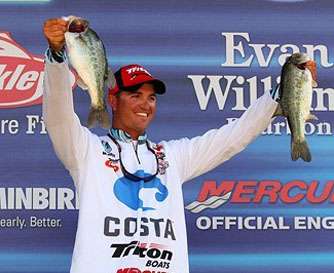
He may be young but Casey Ashley has been around long enough to observe how blueback herring have changed bass fishing in the lakes near his hometown of Donalds, S.C. And the effect has been dramatic.
What it has created is a summertime bite for bass that’s topwater all the time.
“I live on four lakes that are all herring lakes,” Ashley said. “You’ve got Hartwell, Russell, Clark’s Hill and Murray. Growing up, that’s pretty much all the lakes I fished. When I was younger, the herring hadn’t gotten populated in those lakes like they are now, so they weren’t really keying on them.”
But now, according to Ashley, blueback herring are by far the baitfish that bass prefer year-round in the lakes where their populations have become established. Blueback herring are primarily found in saltwater, but because they can live in both fresh- and saltwater, they have made a second home in the lakes around Ashley’s hometown.
Early in the year, you can target bass that are feeding on spawning herring. Those will be extremely shallow, “in the dirt,” as Ashley likes to say.
But once the spawn is over, blueback herring begin showing their saltwater behavior, which is to suspend in deep water. You might not think that would lead to such a strong summertime topwater bite, but it does.
“When those herring get finished spawning, they pull out,” said Ashley. “Creek turns and points still play a role, but you don’t pay attention to the bottom anymore. They just get to a certain depth of water. But they’re still going to be close to some kind of structure.
“And the bass, when they are chasing herring, are always looking up. The only way you’re going to get them to bite, even with topwater, is to fish it as fast as you can. This time of year, even when it’s 95 degrees and glass-slick calm, you can still catch them.”
Ashley’s favorite lure for catching bass on these blueback herring lakes is a double Zoom Fluke rig. He uses a Super Fluke, which is the middle size in this soft plastic bait. Pearl white is a good color, and glimmer blue is okay. But Ashley said the disco green color imitates the color of a blueback herring best of all.
He rigs them fairly close together, but far enough apart that they look like two distinct baits in the water, not one. And he casts them on 15-pound test fluorocarbon.
“There are all kinds of tricks to it, but as far as trying to find fish, you have to cast,” he said. “There’s no way to mark them. You just have to throw. You can’t look at a point and say, ‘There’s going to be bass over there.’ And you can’t rely on a graph because you’re not going to mark those herring.”
However, it doesn’t take long to find out if bass are feeding on herring when you get to one of those deep drops off a point or channel swing.
“Once you figure it out, it’s real easy to find them,” Ashley said. “You can really fish fast. You don’t even have to work that double-Fluke. Just throw it out there, hold your rod high, wind it as fast as you can and make both Flukes skip over the top of the water. They’ll come up and just annihilate it.”
One tactic local anglers use to help locate herring is putting out tall cane brushpiles. This is more of a vertical structure. Cane as tall as 20 feet is placed in 5-gallon buckets filled with rocks or cement.
“The key is to make them stand tall and put them in deep water,” Ashley said. “All it does is give you something to throw to.”
The herring won’t be down in the cane pile, but suspended around it, just like they do on points with big depth changes.
“If a point runs out real flat, then drops to 40 or 60 or 80 feet,” Ashley said, “that’s where you’re going to start looking, right where it breaks. I don’t know why but they hang on the break.”
If you don’t want to throw a Fluke, Ashley recommends a pair of Lucky Craft lures – the Sammy and the Gunfish.
Ashley said there’s a father-and-son team near his hometown that is hard to beat on blueback herring lakes. They choose a double-team approach, with the father fishing a Super Spook in the front of the boat and the son throwing a Fluke behind him.
“If the guy in the front doesn’t catch one, he’s at least made the fish look at it,” Ashley said. “Then the guy in the back will catch one. They’ve been doing that a long time.”
Originally published July 2011




